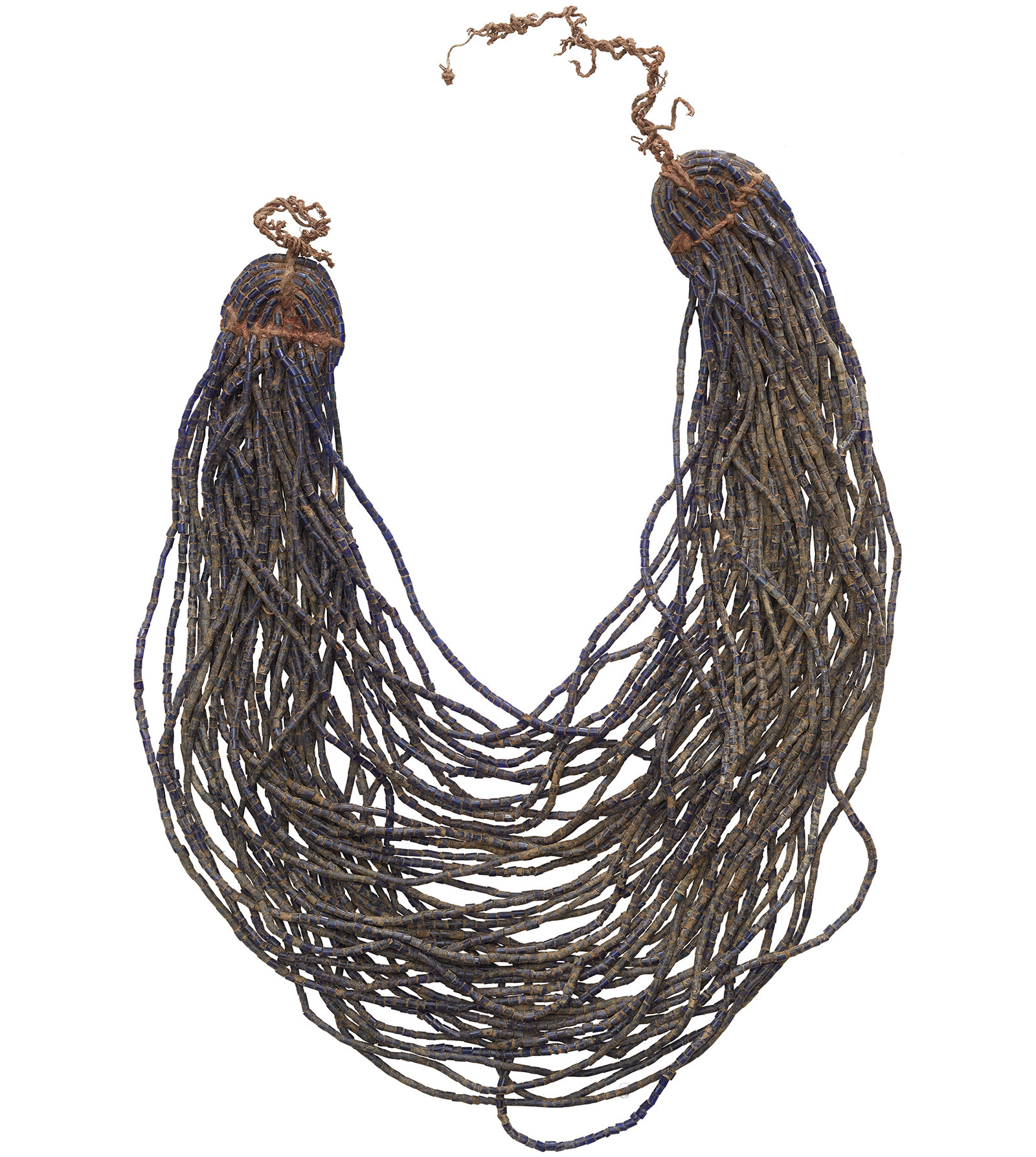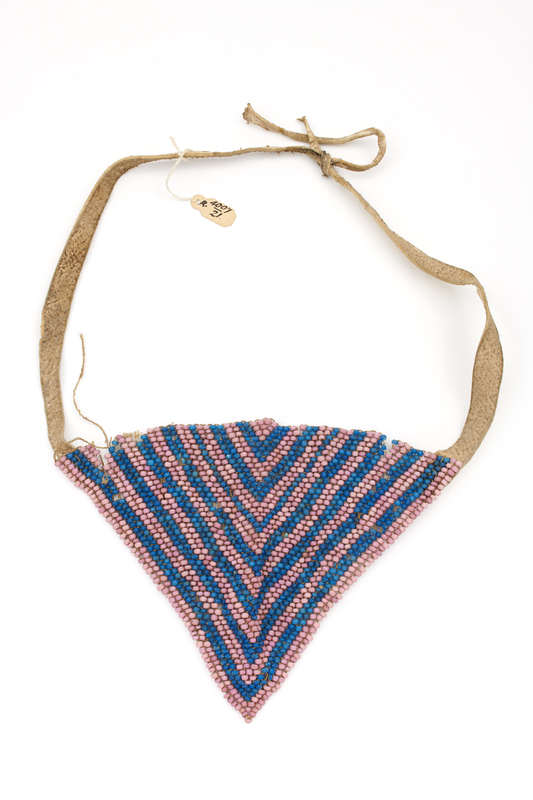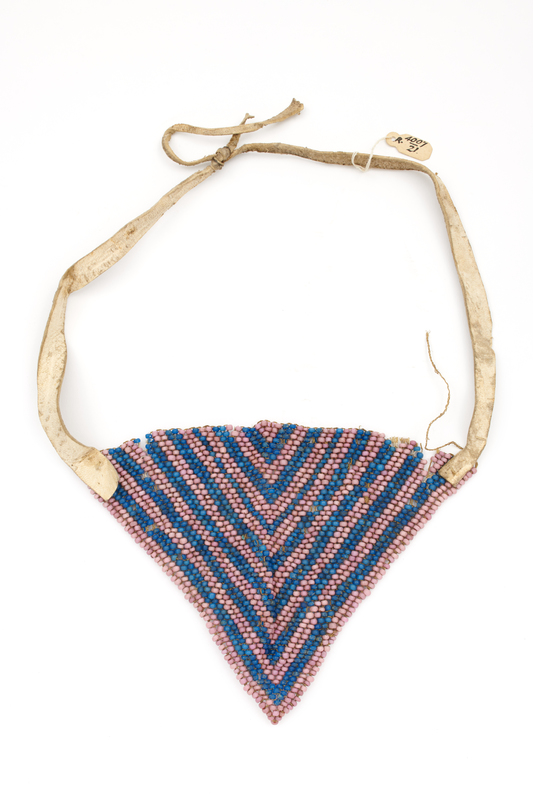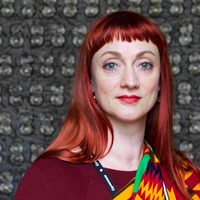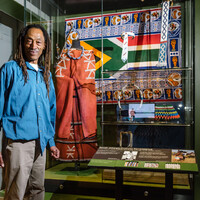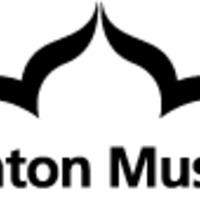Apron; Tshega
Item
Title
Apron; Tshega
Creator
Unrecorded
Subject
Beadwork
Description
Physical Description: A beaded apron or loin ornament made for a Tswana boy. This apron is triangular in shape and decorated with double lines of pink and blue beads in chevron stripes. [Royal Pavilion & Museums]
Contextual Description: Tshega is boys loin covering, ie. More than a decoration. TS comments
Contextual Description: 01:14:30 He indicated the point, and some people will say that this triangle, or this point has a meaning, like you know it is covering something that is also pointing downwards.He said it was also advantageous to have a long point because when we sit down of course this thing has a mind of its own. Each time when you sit down it will go that way [gestures up] so people say hey! Cover yourself up, so you can pull the point in between your buttocks and keep it there.
RHH: Keep everything in place.
01:15:33 [Tswana discussion]
Everyone who wears one we all have the same problem, because it will…its here [gestures] but when you start running to catch up with a goat, your legs will move it. It will find a reason to be on the side, and you want it here! [the centre] when you are running your grandfather or your uncle, father is shouting orders like ‘if you don’t hurry and bring those goats here you’re going to hear from me direct!’ then you’re trying to like, cover yourself because there will be people walking towards you and you are dangling [laughs] so you try to like cover yourself, and they will shout like
‘What is that you are holding in front of you, what is that, you come back here I’ll cut that thing if its delaying you!
Keep running, finish that mission and then you adjust your little thing.
Then again is was an issue when you tried to sit down. When I bring water or something to an elder I’d sit like this [squats] and the moment I do, the thing looks up, and I’m not covered!
So that’s the Tshega blues!
And interestingly that the term that, I don’t know if it was originally but later on the the grannies and our mums to some extent would call any triangle that. Even when they were making geometric designs on their walls, and they make triangular patterns, they’ll call those Tshega. Transcription by KL of MAC_BB_20190817_RPM3 SL Interview with Tshupo Ntono, Village Elder, Language: Setswana with English translations by SL, 2019
RHH: Keep everything in place.
01:15:33 [Tswana discussion]
Everyone who wears one we all have the same problem, because it will…its here [gestures] but when you start running to catch up with a goat, your legs will move it. It will find a reason to be on the side, and you want it here! [the centre] when you are running your grandfather or your uncle, father is shouting orders like ‘if you don’t hurry and bring those goats here you’re going to hear from me direct!’ then you’re trying to like, cover yourself because there will be people walking towards you and you are dangling [laughs] so you try to like cover yourself, and they will shout like
‘What is that you are holding in front of you, what is that, you come back here I’ll cut that thing if its delaying you!
Keep running, finish that mission and then you adjust your little thing.
Then again is was an issue when you tried to sit down. When I bring water or something to an elder I’d sit like this [squats] and the moment I do, the thing looks up, and I’m not covered!
So that’s the Tshega blues!
And interestingly that the term that, I don’t know if it was originally but later on the the grannies and our mums to some extent would call any triangle that. Even when they were making geometric designs on their walls, and they make triangular patterns, they’ll call those Tshega. Transcription by KL of MAC_BB_20190817_RPM3 SL Interview with Tshupo Ntono, Village Elder, Language: Setswana with English translations by SL, 2019
Publisher
Making African Connections
Date
Pre 1899
Type
PhysicalObject
Format
Whole: 280 mm x 180 mm x 3 mm
leather; glass
Identifier
R4007/21
Source
Collected by Reverend William Charles Willoughby, a Christian missionary, in what was then the Bechuanaland Protectorate (1885-1966). It is now the Republic of Botswana, having gained independence from Britain in 1966.
From 1889-92 Willoughby was pastor at Union Street Church, Brighton (now The Font pub). From 1893 to 1898 he worked for the London Missionary Society in Bechuanaland. He assembled this collection of objects during this period. This was a period of social and technological changes and these objects represent traditional lifestyles and skills, rather than the contemporary lives of the people Willoughby met.
Willoughby's collection was loaned to Brighton Museum in 1899 when he returned to the UK. The loan was converted into a donation in 1936, and accessioned as acquisition R4007.
Some objects were re-numbered with the WA (World Art) numbering system in the 2000s. These numbers have been reverted to the original R4007/... numbers where possible for consistency in 2019.
This object was on display in the exhibition 'Missionary Collectors' in the James Green Gallery of World Art, from July 2004 to January 2005.
From 1889-92 Willoughby was pastor at Union Street Church, Brighton (now The Font pub). From 1893 to 1898 he worked for the London Missionary Society in Bechuanaland. He assembled this collection of objects during this period. This was a period of social and technological changes and these objects represent traditional lifestyles and skills, rather than the contemporary lives of the people Willoughby met.
Willoughby's collection was loaned to Brighton Museum in 1899 when he returned to the UK. The loan was converted into a donation in 1936, and accessioned as acquisition R4007.
Some objects were re-numbered with the WA (World Art) numbering system in the 2000s. These numbers have been reverted to the original R4007/... numbers where possible for consistency in 2019.
This object was on display in the exhibition 'Missionary Collectors' in the James Green Gallery of World Art, from July 2004 to January 2005.
William Charles Willoughby
Botswana, Southern Africa, Africa
1893-1898
Space/Place
Botswana, Southern Africa, Africa
Cultural Group: Tswana
Rights
Creative Commons Attribution-ShareAlike 4.0 International
Item sets
Linked resources
Filter by property
| Title | Alternate label | Class |
|---|---|---|
 Beadwork Beadwork |

